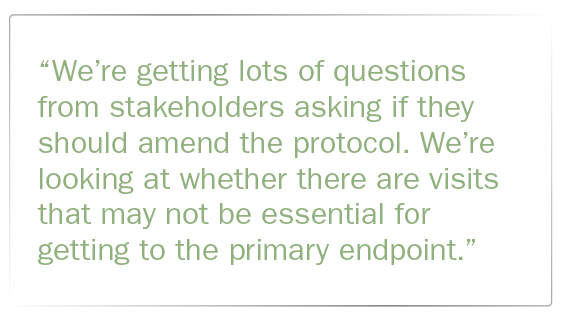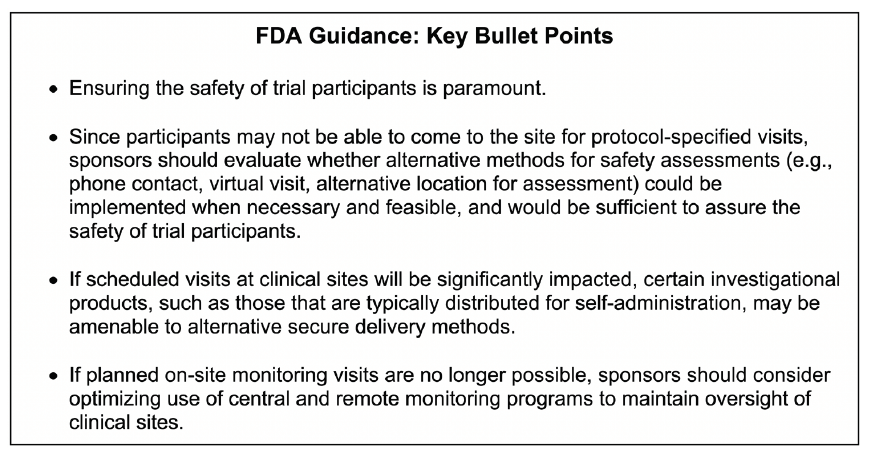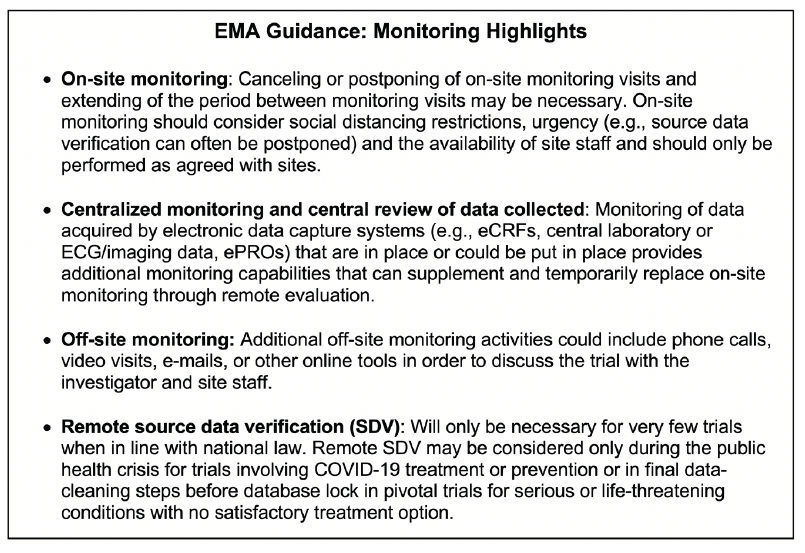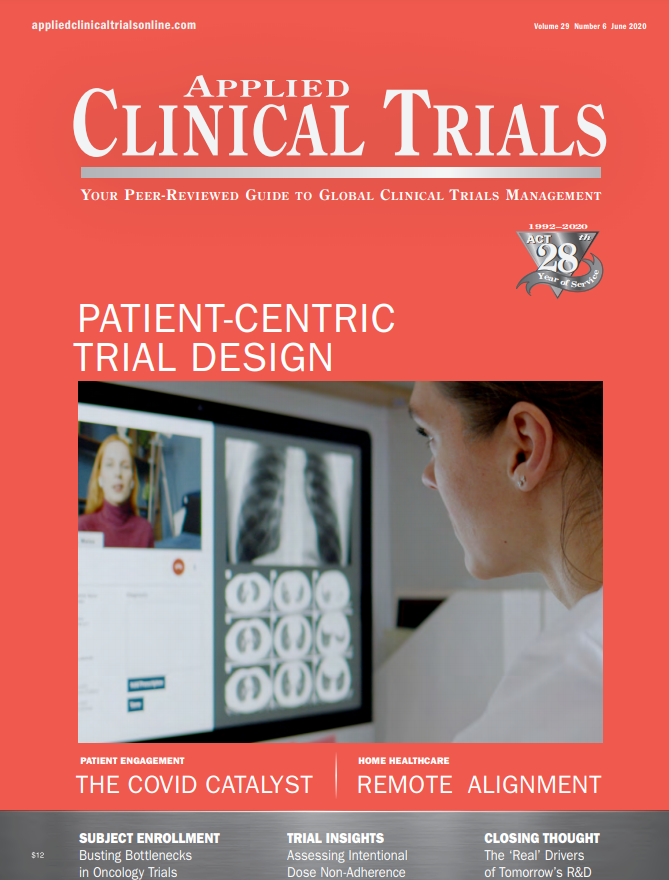COVID-Sparked Practices Driving New Patient-Centric Behaviors
Applied Clinical Trials
Clinical trial stakeholders weigh in on the major shifts unfolding in the era of COVID-19, as efforts move away from the traditional site-based model.

In 2000, Malcolm Gladwell’s The Tipping Point became a runaway bestseller by describing the factors that fuel an epidemic, and how the world suddenly becomes a different place as it reaches the inflection point. He discusses epidemics as spreading quickly like a virus, causing people to start behaving differently, triggering contagiousness, whether it applies to fashion trends, the uptake of cell phones, or the spread of disease. Gladwell’s explanation of how epidemics occur bears an uncanny resemblance to what is happening in the clinical trials sector as stakeholders are abruptly changing entrenched study behaviors due to the impact of the COVID-19 pandemic, raising questions as to whether these changes will persist once it subsides.
This article takes a look at an industry in flux, with the pandemic driving a long-awaited trend away from the traditional site-based study model toward one that is more patient-centric, meaning that decentralized and hybrid approaches may finally be taking hold. These newer methods, which include home study visits, telemedicine, and remote monitoring, have been happening over the past few years, but uptake has been slow, reflecting the clinical trials industry’s renowned conservative view of change, often citing regulatory concerns, and clinging to an “if it ain’t broke, don’t fix it” attitude. This resistance has stubbornly persisted despite sobering statistics. A recent study from the Tufts Center for the Study of Drug Development (CSDD) found no significant differences in the mean number of patients enrolled per site or by therapeutic area in 2019 versus 2012.1 The study also showed that late development studies had a higher average drop-out rate in 2019 (19.1%) than in 2012 (15.3%).
This may all be about to change, and fast, due to the COVID-19 pandemic. Suddenly, with participants unable to get to the site, or unwilling to travel for fear of contracting the virus, sponsors and contract research organizations (CROs) are anxious to embrace patient-friendly decentralized practices in a big way, hoping to curb the number of studies that are shutting down or not starting at all. Darcy Forman, vice president of clinical operations for Science 37, a provider of virtual clinical trials, comments, “We have been unbelievably busy with this pandemic as sponsors are wanting to transition to a virtual model. It’s really accelerating, and they are finally pushing through their hesitancy.”
Part of this patient-centric effort includes growing interest in simplifying protocols, and documenting those changes. Michael Cioffi, senior vice president of clinical solutions and strategic partnerships with WCG,

remarks, “We’re getting lots of questions from stakeholders asking if they should amend the protocol. We’re looking at whether there are visits in the protocol that may not be essential for getting to the primary endpoint.”
To explore these major shifts, several clinical trial stakeholders were interviewed to gain an understanding of remote processes unfolding in the era of COVID-19, and how smart technologies and mobile health staff are key to sites making this transformation. The larger question is whether their wider acceptance will be the inflection point that truly upends the status quo. In the long term, the intent is to remove some of the barriers of traditional models of study conduct, resulting in faster and more productive clinical trials.
Upheaval now
Starting in March, stories began appearing about sponsors slashing clinical trial activity as the coronavirus was actively spreading across the globe.2,3 This slow-down reflects an all-out effort to protect the trial participants and site staff, meaning that study visits are being reduced, shifted to tele-visits, or cut entirely. Also, large numbers of healthcare staff are being re-routed to care for patients infected with the coronavirus. A recent webcast by WCG included ethicist Dr. Arthur Caplan, professor of bioethics and founding director, Division of Medical Ethics, NYU Langone Medical Center, who discussed this chaotic activity.4 “Morally, we are trying to shift away from autonomy toward protection of the community,” he said. “We want to reduce the impact of the pandemic, so we are trying not to conduct research unless it is absolutely benefiting a person, and taking it away would harm them.”
At the same time, a startling number of new trials dedicated to vaccine study, development of therapies, or observational case studies are ramping up. As of May 29, clinicaltrials.gov listed more than 1,800 studies for COVID-19 in various stages being conducted the world over.5 Most-85%-are either recruiting or have not yet started recruiting, but the short descriptions of each trial make it difficult to tease out how many visits will be virtual or will include home visits.
To minimize confusion and to help stakeholders safely conduct these clinical trials during the era of COVID-19, regulatory agencies have released guidelines6, with FDA7 and the European Medicines Agency (EMA)8 having put forth guidances in March. And with the pandemic a changing picture, both guidances have already been updated.
The FDA guidance was implemented immediately and without prior public comment due to the urgency of the situation, and its recommendations are intended to remain in effect only for the duration of the COVID-19 public health emergency. This guidance includes a number of bullet points and a Questions and Answers Appendix focused on ensuring the safety of trial participants. Importantly, there is a statement about use of alternative and remote methods for safety assessments, such as phone contact, virtual visits, and alternative locations for assessment, and sponsors should be determining if in-person visits are necessary to assure trial safety. Also, sponsors should consider whether participant safety can be assured through use of remote monitoring. The box below lists a sampling of the bullet points in the FDA guidance.

Similarly, the EMA guidance states that actions for ongoing clinical trials should be based on benefit-risk considerations from national and local perspectives, with priority given to the impact on the health and safety of the trial participant. This may include conversion of physical visits into phone or video visits, postponement of visits, or complete cancellation to ensure that only strictly necessary visits are performed at sites. Changes to studies should avoid further burdening of sites in terms of time and staffing during the pandemic. As for new trials, the feasibility and immediate necessity of starting them should be critically assessed by sponsors in close collaboration with stakeholders, especially investigators. This guidance includes a section on monitoring methods (see highlights below).

The COVID Catalyst
The sharp turn toward more patient-centric study models is perhaps the single-most dramatic change to the clinical trials landscape. Jim Kremidas, executive director of the Association of Clinical Research Professionals (ACRP), says, “The silver lining in all this is what we might call the COVID Catalyst for decentralized trials.”
Finally, the traditional study model, whereby all visits take place at the site, is giving way to a more virtual approach, with technologies and platforms enabling this transition. One example is Science 37’s platform, which brings clinical research into the home, facilitating interactions between participants and study teams by supporting virtual patient recruitment, electronic consent, videoconferencing, and data collection by electronic clinical outcomes assessment (eCOA). In addition, for some trials, the study product is shipped directly to patient homes. Mobile teams are trained to do home visits, which may include blood draws, and in some instances, home infusion. To ensure the safety of patients and staff, Science 37 has an in-home COVID-19 protocol in place, which conforms to the FDA guidance.
Megan Liles, executive director, operational strategy and feasibility for clinical trials, at Precision for Medicine, a service provider for biomarker studies, explains that for oncology trials, sponsors are actively seeking a more patient-centric approach. “At this time, sponsors are looking at their protocols to see if there are opportunities to make home-based visits or telemedicine-type visits,” she says. “They are also looking at ways to scale back on the number of procedures, and put flexibility in the protocol. This is an immediate need.”
As patient visits become more remote, monitoring activity is following suit. The growing interest in remote monitoring capability is evidenced by regulatory input, and the number of articles,8,9 webinars, or portions of webinars on this subject. WCG’s Cioffi comments that as remote monitoring gains attention, sponsors are concerned about being able to monitor the quality of the data appropriately. “Not every sponsor is comfortable with remote SDV. But if they are, they need to ensure the mechanics of it, such as having the proper monitoring plan in place to allow for this,” he says. “The challenge they have is their concern that protected health information could be transmitted, and a lot of people are very uncomfortable with that. Some companies have secure portals, where the source documents are being redacted and then uploaded.”
Cioffi adds that sites also have issues with remote monitoring, as source documents cannot leave the site, and any efforts to monitor them remotely must be in accordance with HIPAA guidelines. For many sites, this is new ground.
Tough time for sites
With study pipelines being cut, sites are facing very real issues of viability linked to furloughing staff, downsizing, or outright demise of their sites. To quantify the impact of COVID-19 on study activity, ACRP, in partnership with Continuum Clinical, a patient recruitment provider, released results of an online survey for U.S. sites in early April.10 The 297 respondents revealed that sites not actively working on COVID-19-related studies are being heavily impacted by the global pandemic. Nearly one-third (31%) reported fear of total site closure as stay-at-home orders and patient concerns over interacting with healthcare professionals were stepped up. Seventy-seven percent stated that at least one of their current clinical trials had been put on hold or cancelled in recent weeks.
Also disturbing is the fact that sites are facing serious staffing issues, with 38% claiming that employees are experiencing difficulties working from home, and 33% reporting employees are not fully engaged due to COVID-19-related disruptions.
These data are telling an important story, and according to Kremidas, “Another U.S.-based survey is scheduled for early May. We’ll be tracking some of these issues longitudinally to see if things have changed. Site closure will be asked about, and if that jumps to 50%, that will be another red flag.”
ACRP did conduct a follow-up survey in May (n = 274), and while results are still being tallied at the time of this writing, preliminary findings are somewhat encouraging. Importantly, sites are significantly more optimistic that they will not need to close in the coming weeks. Specifically, 75% indicated that site closure is very unlikely. Also, there was a tremendous increase in the percentage of sites conducting COVID research (from 18% to 43%), and a strong interest in use of telehealth (91%).
As for trials currently on hold, there was a slight rise in the use of telemedicine to maintain patient engagement.
Clinical Score, a provider of patient-centric drug development and commercialization services, also conducted a recent online site survey.11 This one, with responses from 363 sites in 42 countries, also highlighted the toll that treating patients with COVID-19 is taking on site staff, including their ability to obtain supplies, equipment, and labs. An impressive 92% claimed that they have attempted to keep trials on schedule, and as evidence of the ongoing shift, 36% of sites responded that virtual site visits is currently their most commonly used approach. But still, the difficulty of modifying protocols because patients are not coming in for study visits was too great for 34% of enrolling sites, so they opted to stop seeing study patients, or moved to virtual trials.
These findings raise questions as to how ready sites will be able to ramp up as the clinical trials sector eventually attempts to resume studies beyond those for COVID-19 treatments or vaccines. “Investigative sites are the most important piece of the supply chain,” says Kremidas. “When this thing ends, there will be a whole backlog of new trials that sponsors want to do without a workforce to do it. The shortage of sites is going to slow down development of drugs and raise the cost.”
ACRP is launching an initiative to help sites through this tough time, and is actively seeking partners to assist in this effort.
At the tipping point
Gladwell says that getting to the so-called tipping point is all about an epidemic spreading in such a way that unexpected behavior becomes expected, and radical change is more than a possibility-it becomes certainty. But, as the clinical trials world is heading toward a more patient-centric model, with redesigned protocols, including a mix of on-site, remote, and home visits made possible with digital tools, it’s not entirely clear what elements of this abrupt change will remain post-COVID, and which will slip back to the old model. Opinions are mostly optimistic, as there is a sense that stakeholders are ready to snap out of perpetual pilot mode, and embrace the technologies needed to conduct more efficient clinical research.
“Before the pandemic, I heard more interest from sponsors in virtual visits because it’s becoming more important to take the trial to where the patients are,” says Precision for Medicine’s Liles. “Especially since our trials are biomarker-driven, we are dealing with a very small population of patients, so there is going to be more interest in this approach. I hope this is the catalyst we need. On the other hand, some project managers said they’ve heard that after the pandemic, they’ll be going back to 100% SDV rather than moving toward risk-based monitoring.”
Brian Neman, CEO and founder of Sanguine Biosciences, a provider of mobile health staff for clinical trials, remarks, “Sponsors often perceived home visits as a risk, but now, they are considering it a risk-mitigation strategy. In line with that concept, I think some sponsors will stop over-auditing, meaning an overhaul of the vendor review and qualification process. For example, is it wise for smaller companies, like those with less than 100 employees, to spend precious time and resources auditing global service providers, such as Amazon Web Services or Salesforce.com? That time could be better spent adopting technologies that have entered the space that facilitate patient centricity.”
Making the changes more likely to stay after the pandemic will involve addressing how a remote model will enable the study drug to get to the patient, how the patient will be monitored, how the data will be analyzed, and which sites are best prepared to go with the new flow. These are long-simmering questions about clinical research that are finally starting to get answered.
Ann Neuer, MBA, is President of Medical deScriptions, LLC
References
1. Batista G, Lowy P. Tufts CSDD Impact Report January/February 2020, Vol. 22(1). Press Release. January 2020. Available at: https://csdd.tufts.edu/csddnews. Accessed April 24, 2020.
2. Lee J. Lilly to Halt Enrollment in Clinical Trials as a Result of COVID-19. MarketWatch. March 23, 2020. Available at: https://www.marketwatch.com/story/lilly-to-halt-enrollment-in-clinical-trials-as-a-result-of-covid-19-2020-03-23?siteid=yhoof2&yptr=yahoo. Accessed April 27, 2020.
3. Fidler B. Guide to Clinical Trials Disrupted by the Coronavirus Pandemic. Biopharma Dive. April 22, 2020. Available at: https://www.biopharmadive.com/news/coronavirus-clinical-trial-disruption-biotech-pharma/574609/. Accessed April 27, 2020.
4. Part 1: Clinical Trials in the Era of COVID-19: Changes You Need to Make Now. WCG Webinar Series. March 18, 2020. https://www.wcgclinical.com/events/covid-19-webinar-series/. Accessed April 27, 2020.
5. Clinicaltrials.gov. COVID-19 Studies. May 29, 2020. Available at: https://clinicaltrials.gov/ct2/results?term=COVID-19&Search=Clear&age_v=&gndr=&type=&rslt=. Accessed May 29, 2020.
6. Heelan B. COVID-19 Pandemic and Regulatory Guidelines on Clinical Trial Conduct; Similarities and Differences Between Regions. PAREXEL. March 27, 2020. Available at: https://www.parexel.com/news-events-resources/blog/covid-19-pandemic-and-regulatory-guidelines-clinical-trial-conduct-similarities-and-differences-between-regions. Accessed May 4, 2020.
7. FDA Guidance on Conduct of Clinical Trials of Medical Products during COVID-19 Public Health Emergency. Food and Drug Administration. May 14, 2020. Available at:. https://www.fda.gov/media/136238/download. Accessed May 28, 2020.
8. Guidance on the Management of Clinical Trials During the COVID-19 (Coronavirus) Pandemic. European Medicines Agency. April 28, 2020. Available at: https://ec.europa.eu/health/sites/health/files/files/eudralex/vol-10/guidanceclinicaltrials_covid19_en.pdf. Accessed April 28, 2020.
9. Johnson T, Yee H. Adjusting To Clinical Trial Remote Monitoring During COVID-19: Working Smarter & Safer. Halloran Consulting Group. Clinical Leader. April 10, 2020. Available at: https://www.clinicalleader.com/doc/adjusting-to-clinical-trial-remote-monitoring-during-covid-working-smarter-safer-0001. Accessed April 30, 2020.
10. COVID-19 Regulatory Developments Impacting Technology Use in Clinical Trials. Medidata Blog. April 30, 2020. Available at:Accessed April 30, 2020.
11. Survey Shows One-Third of Clinical Trial Study Sites Fear Total Closure; 77% Indicate at Least Some Ongoing Research Trials Have Been Impacted Due to COVID-19. Association of Clinical Research Professionals. Continuum Clinical. April 8, 2020. Available at: https://acrpnet.org/2020/04/08/survey-shows-one-third-of-clinical-trial-study-sites-fear-total-closure-77-indicate-at-least-some-ongoing-research-trials-have-been-impacted-due-to-covid-19/?. Accessed May 1, 2020.
12. Kaplan GA, Weaver R, Cloud B. The Effect of COVID-19 on Clinical Trials: Insights from the Inside. Applied Clinical Trials. April 7, 2020. Available at: http://www.appliedclinicaltrialsonline.com/effect-covid-19-clinical-trials-insights-inside?pageID=1. Accessed May 1, 2020.

Improving Relationships and Diversifying the Site Selection Process
April 17th 2025In this episode of the Applied Clinical Trials Podcast, Liz Beatty, co-founder and chief strategy officer, Inato, discusses a number of topics around site engagement including community-based sites, the role of technology in improving site/sponsor relationships, how increased operational costs are impacting the industry, and more.
Behind the Buzz: Why Clinical Research Leaders Flock to SCOPE Summit
February 7th 2025In this episode, we meet with Micah Lieberman, Executive Conference Director for SCOPE Summit (Summit for Clinical Ops Executives) at Cambridge Innovation Institute. We will dive deep into the critical role of collaboration within the clinical research ecosystem. How do we bring together diverse stakeholders—sponsors, CROs, clinical trial tech innovators, suppliers, patients, sites, advocacy organizations, investors, and non-profits—to share best practices in trial design, program planning, innovation, and clinical operations? We’ll explore why it’s vital for thought leaders to step beyond their own organizations and learn from others, exchanging ideas that drive advancements in clinical research. Additionally, we’ll discuss the pivotal role of scientific conferences like SCOPE Summit in fostering these essential connections and collaborations, helping shape the future of clinical trials. Join us as we uncover how collective wisdom and cross-industry partnerships are transforming the landscape of clinical research.